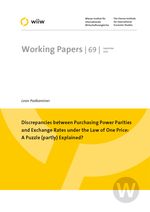Discrepancies between Purchasing Power Parities and Exchange Rates under the Law of One Price: A Puzzle (partly) Explained?
wiiw Working Paper No. 69, September 2010
18 pages including 5 Tables
European Comparison Project data (years 1999-2008) are used for an estimation of cross-country systems (AIDS) of consumer demand functions defined over durable and non-durable tradable goods and non-tradable services. General exchange equilibrium models of inter-EU trade generate equalized relative prices of tradable goods. But domestic relative prices of services become more dispersed and can move the PPP/ER ratios away from unity. PPP/ER discrepancies may be sustained even when there are no impediments to free trade.
Keywords: Purchasing Power Parity, exchange rate, PPP/ER discrepancy, Law of One Price, Balassa-Samuelson Effect, trade integration, computable general equilibrium, cross-country systems of demand functions, Almost Ideal Demand System, tradable goods, non-tradable goods
JEL classification: F11, F15, D12, D58, F31, O57
Countries covered: European Union
Research Areas: Macroeconomic Analysis and Policy
